Over 17,000 freight trains passed Gotthard Base Tunnel

More than 17,000 freight trains have passed through the Gotthard Base Tunnel since its opening in June last year, revealed Swiss Federal Railways (SBB). Though the construction of what became world’s longest railway tunnel has spurred freight movement on the Rotterdam-Genoa corridor, its full potential is yet to be reached in 2020, the national company promises.
The Gotthard Base Tunnel was officially opened on the 1st of June 2016, but full service commenced on the 11th of December of that year. The first flat, low-level route through the Alps indicated a breakthrough for the rail freight industry operating between northern Europe and Italy and since then, volume numbers have already significantly increased.
Full potential
When the north-south route will be cleared for 750-meter trains with a 4-meter profile, rail freight on this route is anticipated to witness an even further increase. This is set to happen with the opening of the Ceneri Base Tunnel in 2020, a milestone much anticipated by rail freight operators.
In the past few months, freight trains passing the tunnel averaged 1080 tonnes in weight and 434 meter in length. With accessibility to 750-meter trains, the maximum weight will be raised from 1600 to 2000 tonnes and the daily capacity will rise from 210 paths to 260, according to SBB. “With improved production parameters such as these, we are able to produce more efficiently and thus compensate the reduction in operating subsidies,” said Bernhard Kunz, Managing Director at Hupac, noting a decrease of route by 30 kilometers, fewer stops to change locomotives and lower energy consumption as contributing factors.
Challenges
There are however challenges on the road. Currently, the biggest challenge proves the 6-months closure of the Luino line for gauge enhancement work. A high number of trains are rerouted via the Lötschberg/Simplon axis, causing frequent delays. Furthermore, waiting times at international borders can be long due to procedural hassles. this leads to further delays in Switzerland. “If we want to keep up with the road, standards have to be simplified and harmonised throughout Europe. This involves qualification procedures for rolling stock, train-path price systems, safety and operating requirements, language regulations for train drivers, and much more”, commented Kunz.
You just read one of our premium articles free of charge
Want full access? Take advantage of our exclusive offer





